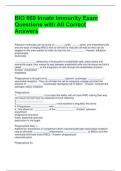BIO 669 Innate Immunity Exam
Questions with All Correct
Answers
Adhesion molecules can be found on _______cytes, ______cytes, and endothelial cells
and are ways of helping WBCs stick to cell wall or vascular cell wall so they can be
stopped in the area needed to make its way into the _________. - Answer- adhesion
lymphocytes
leukocytes
_______________: adherence of leukocytes to endothelial cells, starts slowly and
eventually stops, then makes its way between endothelial cells into the tissue and that's
called _____________ or the emigration of cells through the endothelial junctions -
Answer- margination
diapedesis
Phagocytosis is brought on by ____________, opsonin, scavenger, ___________--
associated receptors. They can all help the cell to recognize, engage and start the
process of ____________ a potentially damaging cell or debris. - Answer- complement
pathogen-assoc receptors
Phagocytosis:
1. ___________________- if you lose this ability, will not have WBC making their way
into tissue and will have an impaired immune response
2. ___________________-
3_______________ ______________: once bacteria is engulfed, this forms
4. Phagosome _____________ with ____________ ___________
5. This allows for ___________ of the _____________. - Answer- adhesion
engulfment
phagosome formation
fuses, lysosomal granules
destruction fo the target
Phagocytosis Step 1:
Adherence: Importance of complement other important pathogen associated receptors
help to stimulate ___________, inflammation, _________________ of WBCs and then
eventually eliminate those WBCs - Answer- phagocytosis
chemoattraction
Phagocytosis Ex:
,___________ subverts the process by allowing the organism to live within the
___________ and never _________ with the lysosome unless activated by immune
cells. It evolved that now it can be phagocytized, but secretes ________ that prevent
the merge therefore prevent its destruction.
Other molecules like interferon _____ can stimulate the _________________ and other
phagocytes to overcome this block and clear effect. Whether you can secrete the
interferon or not and how much you secrete can play a role in how well you can clear a
particular infection. - Answer- TB
phagosome
merge
molecules
gamma
macrophages
__________ ___________ cells can recognize and eliminate cells infected with viruses.
They don't look for specific peptides like ____________ do, and they don't have same
receptors as neutrophils and macrophages, but have receptors that can recognize
patterns found in __________ or _________ cells and can recognize ________
containing molecules. _______ can go undiagnosed and undetected where as natural
killer cells can take care of it. One of the reasons why patients who are
_______________ have higher rates of cancer. The inhibitory & activating receptors
allow ________________ between normal and abnormal cells. - Answer- Natural killer
lymphocytes
virus or cancer
lipid
immunocompromised
differentiation
Natural killer cells only kill on a ____________ basis no other way. Once they come into
contact with infected or cancerous cell, they release ___________ molecules and
___________ directly into the surface of the cell that will cause the cell to undergo
__________ or ___________ or they will even __________ ______ the cell if it needs
to. These cells produce ______________ and toxic molecules. - Answer- contact
toxic molecules, granzymes
suicide, apotosis
blow up
cytokines
Acute inflammation is __________, as a problem is cleared, whether healing or clearing
infection, the ___________ should resolve.
Local S&S result from __________ changes and corresponding ___________ of
circulating components into the tissue.
S&S include _______, swelling, redness, pain, and _________ fluids - Answer- self-
limiting
inflammation
vascular changes
, leakage
heat, exudative fluids
If inflammation does not resolve, can lead to formation of dead _____, debris, ______.
1. ________ exudate: watery, typically occurs ________ where it's less cellular and
more fluid.
2. ________ exudate: thick, clotted, more _________ such as complement, clotting,
and kinin making it _______. This indicates a more ___________ inflammation
3. ________ exudate: suppurative, pus, indicates a _________ infection, pus is a lot of
____________- and __________ that typically filled with _________ debris and
eventually those cells die as well
4. _________ exudate: contains blood, indicates bleeding - Answer- fluid
1. serous, early
2. fibronous: proteins, thicker
advanced
3. purulent: bacterial, neutrophils, macrophages, phagocytic debris
4. hemorrhagic exudate
Systemic S/S of inflammation
1. ____________ caused by exogenous and endogenous pyrogens
Il-1, IL-6, TNF alpha, act directly on the ___________ to cause a higher set point for
body temperature. Another exogenous pyrogen is _____________________ bc it is
coming from outside the body and can cause the hypothalamus to increase its set
temperature as well.
2. ________________ increased numbers of circulating leukocytes and inc production
and release. ________ ________ rapid inc in number of immature leukocytes as a
result of more rapid production and release into circulation. Indicates an _________
response - Answer- 1. Fever
hypothalamus
lipopolysacchride
2. leukocytosis
left shift
acute response
Systemic S&S of acute inflammation II
Increased plasma _________ synthesis
Early inflammation will cause release of many mediators that will affect the ______
among other tissues
Acute phase reactants:
1. _______
2. _______- part of clotting cascade, can enhance complement system through its
production
3. ____________- a molecule that helps to bind any free hg bc too much hg can release
substances that are harmful to _________, haptoglobin blocks the __________ by
binding to the hg
4. amyloid




